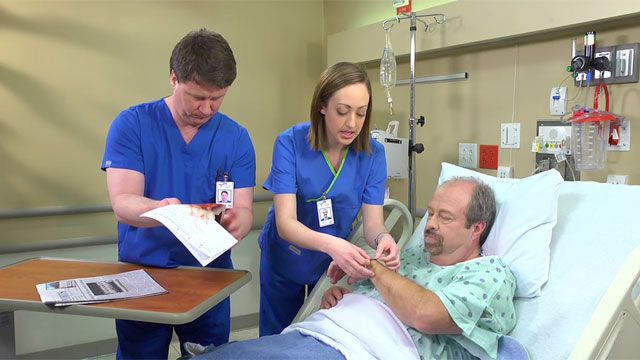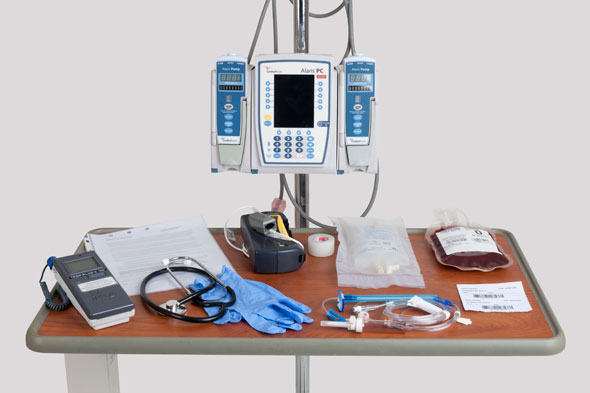Transfusion of Blood and Blood Products
Select a Skill:
- » Preparing for a Transfusion
- » Initiating a Transfusion
- » Monitoring for Adverse Reactions to a Transfusion
Take the Review Test:

Safety
- Ensure that each blood unit is correctly labeled; check the label against the patient’s identification.
- Before administration of blood or blood products, ensure that two nurses verify the correct unit and the correct patient.
- Check to confirm that the required health care provider’s order has been given before administering a blood product.
- Do not heat blood products in a microwave or with hot water, because doing so is dangerous and may destroy blood cells.
- If you notice a discrepancy during the verification process, do not administer the product. Notify the blood bank and other appropriate personnel as indicated by your agency’s policy. Return the blood to the blood bank until the discrepancy has been resolved.
- Initiate the blood transfusion within 30 minutes of the time the blood is released from the blood bank. If the transfusion cannot be initiated within this time frame because of factors such as elevated temperature, immediately return the blood to the blood bank, and retrieve it when you are ready to administer it.
Equipment
(Roll cursor over items to see labels)

Y-type blood administration set (in-line filter)
Signed transfusion consent form
Prescribed blood product
250-mL bag normal saline IV solution
IV pump (if not already in use)
Clean gloves
Tape
Thermometer
Stethoscope
Pulse oximeter
Delegation
The skill of initiating transfusion therapy may not be delegated to nursing assistive personnel (NAP). Delegation of this skill to a licensed practical nurse (LPN) varies and is specified in each state’s Nurse Practice Act. After the transfusion has been started and the patient is stable, monitoring of a patient by NAP does not relieve a registered nurse (RN) of the responsibility of continuing to assess the patient during the transfusion. Be sure to inform NAP of the following:
- Specify the frequency with which vital signs should be monitored.
- Review the information that should be reported to you immediately, including complaints of shortness of breath, hives, or chills.
- Discuss how to obtain blood components from the blood bank according to your agency’s policy.
Preparation
- Verify the health care provider’s orders for the specific blood or blood product, the date, the time at which the transfusion is to begin, its duration, and any pretransfusion or posttransfusion medications to be administered.
- Obtain the patient’s transfusion history, and note any known allergies and previous transfusion reactions. Verify that type and cross-match have been completed within the past 72 hours.
- Verify that the patient’s IV cannula is patent and without complications, such as infiltration or phlebitis.
- Assess laboratory values, such as hematocrit, coagulation values, and platelet count.
- Check that the patient has properly completed and signed the transfusion consent form, and assess his or her understanding of the procedure and its rationale.
- Know the indications for the transfusion.
- Obtain and record the patient’s pretransfusion baseline vital signs, including temperature, pulse, respiration, and blood pressure. If the patient is febrile, which is a temperature greater than 37.8°C (100°F), notify the health care provider before initiating the transfusion.
Follow-up
- Observe the IV site and the status of the infusion each time the vital signs are taken.
- Observe for any changes in the patient’s vital signs and any signs of transfusion reaction, such as chills, flushing, itching, dyspnea, or rash.
- Observe the patient and assess laboratory values to determine the patient’s response to the administration of blood components.
Documentation
- Record pretransfusion medications, vital signs, location and condition of the IV site, and patient education given.
- Record the type and volume of the blood component transfused.
- Record the proper blood unit/donor/recipient identification, compatibility, and expiration date according to agency policy.
Review Questions
1. While checking a blood product prior to administration, the nurse is called away to assist with another procedure. What should the nurse do with the blood product?
 Return it to the blood bank until it can be administered.
Return it to the blood bank until it can be administered. Ask another nurse to administer it to the patient.
Ask another nurse to administer it to the patient. Ask nursing assistive personnel (NAP) to place it in the unit refrigerator if you expect to be gone less than 30 minutes.
Ask nursing assistive personnel (NAP) to place it in the unit refrigerator if you expect to be gone less than 30 minutes. Leave it in the patient’s room.
Leave it in the patient’s room.
2. While checking a blood product prior to administration, the nurse notices that the birth date on the blood bag and requisition do not match the birth date on the patient’s identification bracelet. Which is the correct action for the nurse to take?
 Be especially vigilant for adverse reactions during the infusion.
Be especially vigilant for adverse reactions during the infusion. Ask the patient to state his or her birth date.
Ask the patient to state his or her birth date. Correct the birth date on the blood bag and requisition.
Correct the birth date on the blood bag and requisition. Return the blood to the blood bank.
Return the blood to the blood bank.
3. An adult patient is prescribed to receive a unit of packed red blood cells. Which size intravenous catheter does the patient need to safely receive this blood?
4. The nurse is preparing to administer a unit of blood to a patient in the emergency department and discovers that he is not wearing an identification bracelet. What should the nurse do?
 Identify the patient by asking him to produce a photo ID, such as a driver’s license.
Identify the patient by asking him to produce a photo ID, such as a driver’s license. Administer the blood only if you have been caring for the patient and can be certain of his identity.
Administer the blood only if you have been caring for the patient and can be certain of his identity. Return the unit to the blood bank.
Return the unit to the blood bank. Identify the patient by asking a family member to identify him.
Identify the patient by asking a family member to identify him.
5. While checking a blood bag prior to infusion, the nurse notes that the patient’s blood type is A+ and the donor’s blood type is O+. Which action would the nurse take?
 Administer the blood.
Administer the blood. Return the blood to the blood bank.
Return the blood to the blood bank. Notify the physician.
Notify the physician. Ask the patient if anyone in the family has blood type A+.
Ask the patient if anyone in the family has blood type A+.
You have completed the Review Questions for this skill. To take the Review again select the Start Over button. To proceed to another skill select from the dropdown menu. Select the Home or Back button to proceed to the next section.

